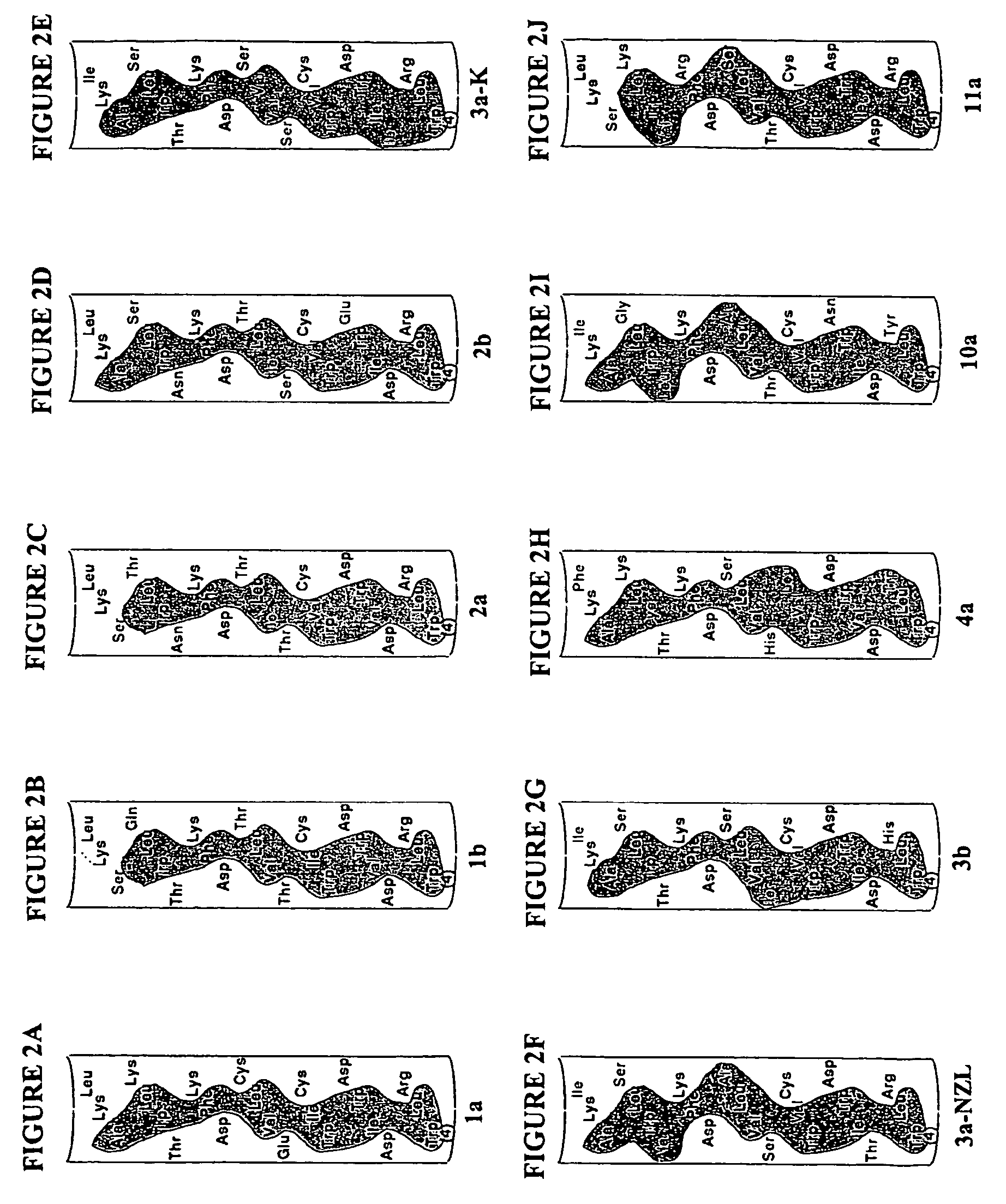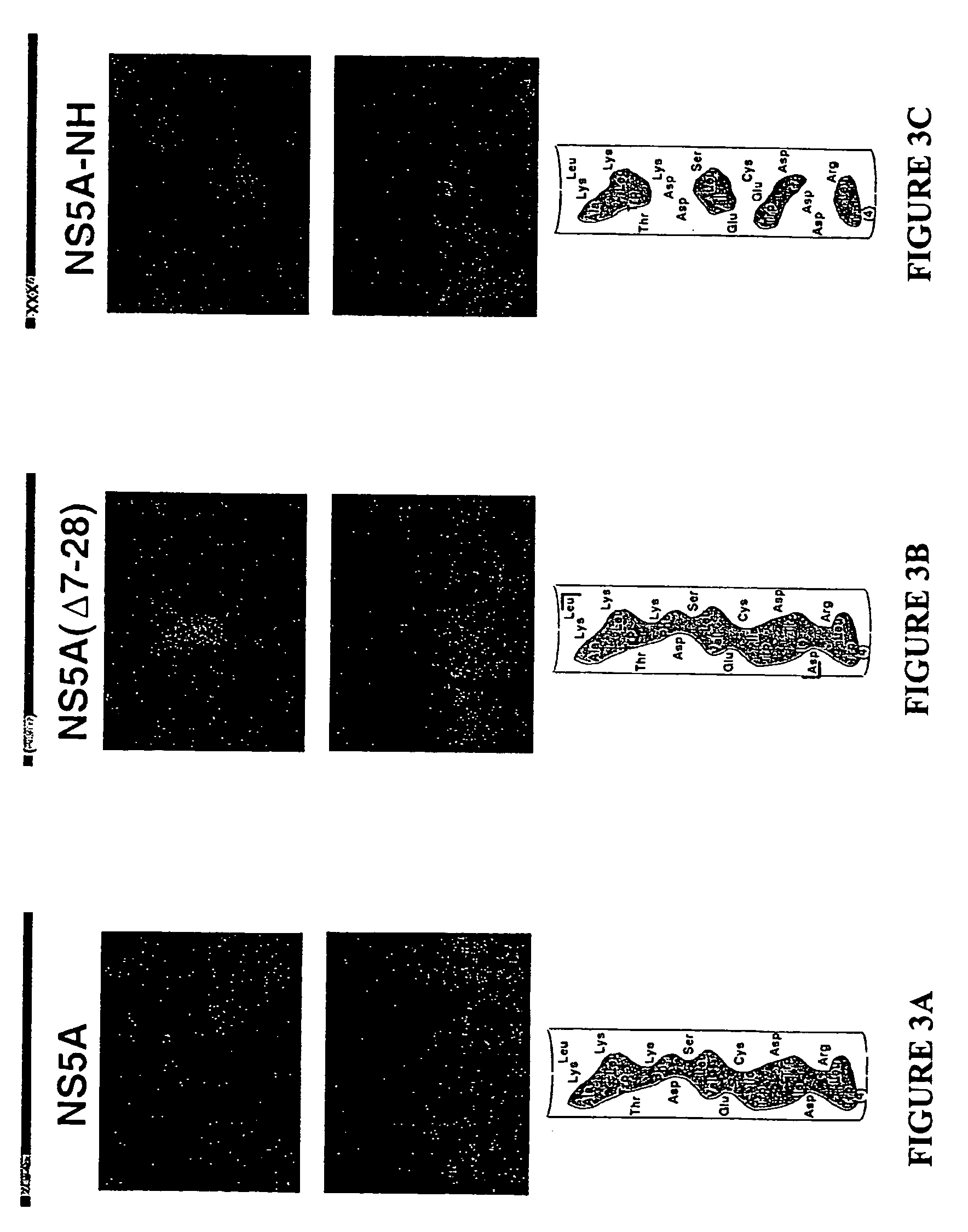Agents for treatment of HCV and methods of use
a technology for hepatitis c virus and agents, applied in the field of agents for treating hcv, can solve the problems of inability of these proteins to properly associate with the cellular membrane,
- Summary
- Abstract
- Description
- Claims
- Application Information
AI Technical Summary
Benefits of technology
Problems solved by technology
Method used
Image
Examples
example 1
Effect of Helix Disruption on Membrane Association
[0109]The bottom panels of FIGS. 3A-3C show the structures of the relevant portion of NS5A used in this example. FIG. 3A shows the amino acid sequence and helix formed at positions 4-27 in the NS5A protein of Hepatitis C virus genotype 1a. FIG. 3B shows the deletion of positions 7-27, thus deleting the helix, as shown by the brackets. This deletion was conducted by PCR mutagenesis essentially as described by Glenn, J. S., et al., J. Virol (1998) 72:9303-9306 on plasmid pBRTM / HCV 827-3011 which encodes the HCV nonstructural proteins as described by Grakoui, A., et al., J. Virol. (1993) 67:1385-1395. This vector encodes the NS proteins under the T7 promoter and encephalomyocarditis internal ribosome entry site control elements and directs the synthesis and processing of proteins NS3, NS4A, NS4B, NS5A and NS5B. FIG. 3C shows a mutant which was obtained using PCR mutagenesis as described above using a primer
[0110]
(5′-TCCGGCTCCTGGCTAAGGGA...
example 2
Intracellular Location of GFP-Labeled Helix
[0116]Three constructs were made. First, as a control, the HCV encoding sequences of pBRTM / HCV 827-3011 were replaced with the coding sequence for jellyfish Aequorea Victoria green fluorescent protein (GFP) using a PCR cloned insert from plasmid C109 which contains E-GFP (Clontech), to obtain “T7-GFP.” A fragment of the NS5A gene encoding the amphipathic helix was fused into frame with the sequence encoding the N-terminus of GFP in T7-GFP by creating a common PstI site using PCR mutagenesis. This permits junction of the first 31 amino acids of NS5A to the 5′ side of serine-2 of the GFP-encoding sequence in T7-GFP. The resulting vector was labeled “T7-5AGFP.” A similar vector, designated “T7-5ANHGFP” was constructed in a manner similar to “T7-5AGFP” except that the corresponding segment from the mutated form of NS5A set forth in FIG. 3C was employed in place of the wildtype helix. Thus, “T7-5ANHGFP” is similar to “T7-5AGFP” except that in th...
example 3
Effect of Helix Disruption on HCV RNA Replication
[0118]Comparative high efficiency, second generation, bicistronic, subgenomic RNA replicons of HCV described by Blight, K. J., et al., Science (2001) 290:1972-1974 were constructed with a neomycin-resistance gene. Similar constructs were made with wildtype NS5A and with NS5A altered in the amphipathic helix as described in Examples 1 and 2. Diagrams of these constructs are shown in the upper panels of FIGS. 5A and 5B.
[0119]The construct containing the wildtype NS5A, Bart79I, was made by PCR mutagenesis of HCVrep1bBartMan / AvaII (Blight, supra) such that nucleotide 5336 was changed from a G to T resulting in a change in NS5A codon 1179 from serine to isoleucine. This mutation results in a dramatic increase in replication efficiency of the HCV subgenomic replicon. Bart5X79I (containing the modified helix) was made by PCR mutagenesis of Bart79I using a primer
[0120]
(5′-GATTGGGATTGGGAATGCACGGTGTTGACT(SEQ ID NO: 453)GATGACAAGACCTGG-3′)
in whi...
PUM
| Property | Measurement | Unit |
|---|---|---|
| Fluorescence | aaaaa | aaaaa |
| Amphipathicity | aaaaa | aaaaa |
Abstract
Description
Claims
Application Information
 Login to View More
Login to View More - R&D
- Intellectual Property
- Life Sciences
- Materials
- Tech Scout
- Unparalleled Data Quality
- Higher Quality Content
- 60% Fewer Hallucinations
Browse by: Latest US Patents, China's latest patents, Technical Efficacy Thesaurus, Application Domain, Technology Topic, Popular Technical Reports.
© 2025 PatSnap. All rights reserved.Legal|Privacy policy|Modern Slavery Act Transparency Statement|Sitemap|About US| Contact US: help@patsnap.com



